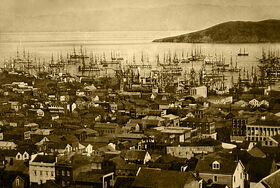
Downtown San Francisco.
San Francisco is a city in the State of California in the United States of America. It is located at the northern end of a peninsula, with the Pacific Ocean to the west and a large, sheltered bay to the east. Nick Knight has lived in San Francisco on more than one occasion.
In the 1850s, he and LaCroix spend a considerable time in Chinatown, engaging in such pursuits as attending cockfights. Nick is struck by the harsh way in which Chinese men treat their concubines; and, in one particular instance, he tries to

In the 1850s, Nick and LaCroix are in San Francisco's Chinatown.
intervene despite LaCroix's advice to leave well enough alone. Although, on that specific occasion, Nick protects the woman from the man hitting her, it simply inflames the man's anger and he later murders her.
Nick and his vampire family are once again in San Francisco in the early years of the twentieth century. In 1916, he pursues a course of acupuncture treatment in the hope that it will enable him to control his vampire appetites, if not cure him. LaCroix and Janette decide to intervene. While Nick is paralysed by the acupuncture needles, they kill Mai Chong, the woman who has been treating him.
It is quite possibly because of the time that he spent in San Francisco that Nick is able to speak Chinese.
History of San Francisco[]

San Francisco in 1822.
The Yelamu, who occupied Northern California from at least the sixth century, had relatively little contact with Europeans until 1769, when an exploration party learned of the existence of San Francisco Bay. Seven years later, in 1776, an expedition selected the site for the Presidio of San Francisco, the military center of Spanish expansion in the area. Later the same year, the Mission San Francisco de Asís was founded. People from the surrounding area were brought to live and work at the mission and be converted into the Catholic faith.
Upon independence from Spain in 1821, the area became part of Mexico. The mission system gradually ended, and lands began to be privatized. In 1835, Englishman William Richardson erected the first independent homestead. A street plan was laid out for the expanded settlement; and the town, named Yerba Buena, began to attract American settlers. California was claimed for the United States on 7 July 1846, during the Mexican-American War; and Yerba Buena was renamed San Francisco the next year. Mexico officially ceded the territory to the United States at the end of the war. Yet, despite its attractive location as a port and naval base, San Francisco was still a small settlement of about a thousand.

San Francisco harbor (Yerba Buena Cove), circa 1850.
The California Gold Rush began on 24 January 1848, when gold was discovered by James W. Marshall at Sutter's Mill, in Coloma, California. It brought a flood of treasure seekers. Prospectors accumulated in San Francisco, raising the population to 25,000 by December 1849. The promise of fabulous riches was so strong that crews on arriving vessels deserted and rushed off to the gold fields. California was quickly granted statehood; and the U.S. military built forts to secure the San Francisco Bay. Silver discoveries, including the Comstock Lode in 1859, further drove rapid population growth. With hordes of fortune seekers streaming through the city, lawlessness was common, and the Barbary Coast section of town gained notoriety as a haven for criminals, prostitution, and gambling.
Entrepreneurs sought to capitalize on the wealth generated by the Gold Rush. The development of the Port of San Francisco established the city as a center of trade. Immigrant laborers made the city a polyglot culture, with Chinese railroad workers creating the city's Chinatown quarter. The city's sea of Victorian houses began to take shape; and the first cable cars ran up Clay Street in 1873. By the turn of the century, San Francisco was a major city known for its flamboyant style, stately hotels, and thriving arts scene.
At 5:12 am on 18 April 1906, a major earthquake struck San Francisco and Northern California. As buildings collapsed from the shaking, ruptured gas lines ignited fires that would spread across the city and burn out of control for several days.
More than three-quarters of the city lay in ruins, including almost all of the downtown core. Contemporary accounts reported that 498 people lost their lives, though modern estimates put the number in the several thousands. More than half the city's population of 400,000 were left homeless. Rebuilding was rapid and performed on a grand scale.

San Francisco's Chinatown today.
In ensuing years, the city solidified its standing as a financial capital; in the wake of the 1929 stock market crash, not a single San Francisco-based bank failed. Indeed, it was at the height of the Great Depression that San Francisco undertook two great civil engineering projects, simultaneously constructing the San Francisco–Oakland Bay Bridge and the Golden Gate Bridge, completing them in 1936 and 1937 respectively. It was in this period that the island of Alcatraz, a former military stockade, began its service as a federal maximum security prison, housing notorious inmates such as Al Capone.
In the mid twentieth century, San Francisco became a magnet for America's counterculture. Beat Generation writers fueled the San Francisco Renaissance and centered on the North Beach neighborhood in the 1950s. Hippies flocked to Haight-Ashbury in the 1960s, reaching a peak with the 1967 Summer of Love. In the 1970s, the city became a center of the gay rights movement.
- Adapted from the Wikipedia article on San Francisco.
